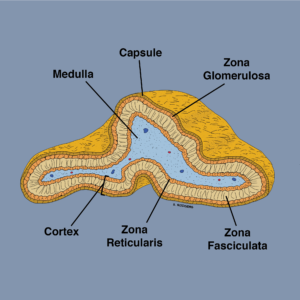 The adrenal gland is an organ that sits in the retroperitoneum (behind the abdominal cavity), just above the kidney. There are two of these glands, one on each side of the body. The adrenal gland is composed of an inner layer called the medulla and an outer layer called the cortex. The cortex is, in turn, composed of three separate layers, each of which produces a different hormone or group of hormones.
The adrenal gland is an organ that sits in the retroperitoneum (behind the abdominal cavity), just above the kidney. There are two of these glands, one on each side of the body. The adrenal gland is composed of an inner layer called the medulla and an outer layer called the cortex. The cortex is, in turn, composed of three separate layers, each of which produces a different hormone or group of hormones.
The Adrenal Medulla
The innermost part of the adrenal gland is called the adrenal medulla. The medulla consists of modified nerve cells that release the neurotransmitters epinephrine (adrenaline) and norepinephrine (noradrenaline) in response to stress. The release of these neurotransmitters is involved in the “fight or flight response.”
A tumor of the adrenal medulla is known as a pheochromocytoma. Patients with a pheochromocytoma typically have poorly-controlled hypertension and episodes of flushing, rapid heart rate, and even panic attacks. Left untreated, a pheochromocytoma can result in a heart attack or stroke. Although pheochromocytomas are most often benign, they can be malignant and metastasize to other sites in the body.
The Adrenal Cortex
The outer layers of the adrenal gland are called the adrenal cortex. The cortex is divided into 3 separate layers, the zona glomerulosa, zona fasciculata, and zona reticularis.
A tumor of the adrenal cortex may be benign (adrenocortical adenoma) or malignant (adrenocortical carcinoma). Tumors of the adrenal cortex may be functional or non-functional. Functional tumors secrete hormones. The specific hormone secreted by the tumor is determined by which of the 3 layers the tumor arises from.
Zona Glomerulosa
The zona glomerulosa is the first layer of the adrenal cortex, just under the capsule. It produces the hormone aldosterone, a mineralocorticoid. Aldosterone functions by signaling the kidneys to retain sodium in the blood stream, thereby drawing more water into blood vessels and raising the blood pressure.
A tumor that secretes aldosterone is called an aldosteronoma. These are almost always benign, and they cause a disease known as primary hyperaldosteronism, or Conn’s syndrome. Patients with Conn’s syndrome usually have poorly-controlled hypertension and hypokalemia (low potassium level in the blood).
Zona Fasciculata
Immediately under the zona glomerulosa is the zona fasciculata. The cells in this layer produce cortisol and other related glucocorticoids. This group of steroids regulates sugar metabolism and has strong effects on wound healing and the immune system.
A tumor arising from the zona glomerulosa and over-producing cortisol causes Cushing’s syndrome. Patients with Cushing’s syndrome gain fat around the face, neck, upper back, and abdomen. If left untreated, this disease process can affect nearly every organ system in the body with devastating consequences.
Zona Reticularis
The third layer of the adrenal cortex, just deep to the zona fasciculata, is the zona reticularis. This layer produces sex hormones, such as the testosterone precursor androstenedione and the related hormones dehydroepiandrosterone (DHEA) and DHEA sulphate (DHEA-S).
Tumors arising from the zona reticularis that produce excess sex hormones are significantly less common than tumors arising from all of the other layers of the adrenal gland. Patients who do have this type of tumor may develop hirsutism (increased hair growth), early puberty, gynecomastia (abnormal breast development in a male), or clitoromegaly (enlargement of the clitoris). The exact symptoms depend on which hormone is being produced, the gender of the patient, and their age (pre-pubescent vs. post-pubescent).
 How to Find an Adrenal Surgeon
How to Find an Adrenal Surgeon
Adrenal surgery may be performed by a general surgeon or sometimes by a urologist. General surgeons who practice adrenal surgery often have specialty training in either endocrine surgery or surgical oncology. Specialty training in these areas requires a one- or two-year fellowship after completing a general surgery residency.
Steven E. Rodgers, MD, PhD
Dr. Rodgers is an experienced adrenal surgeon at the University of Miami Miller School of Medicine and Sylvester Comprehensive Cancer Center near downtown Miami. He is a general surgeon who completed a 2-year fellowship in surgical oncology at the University of Texas M.D. Anderson Cancer Center. Dr. Rodgers has been in practice since 2006, when he completed his training. He routinely performs laparoscopic adrenalectomy and open adrenalectomy. More information about Dr. Rodgers can be found at About Dr. Rodgers and at UMiamiHealth.org.
